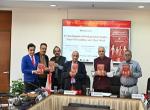The Vivekananda International Foundation held a Vimarsh on 11 September 2020 on The Contemporary Relevance of Swami Vivekananda's Message for the anniversary of the historic speech given by Swami Vivekananda on, 11th September 1893 to the World's Parliament of Religions in Chicago. The main speaker for the event was Swami Sarvapriyananda, Minister & Spiritual Leader, Vedanta Society of New York.
The event was initiated by Dr. Arvind Gupta, Director VIF who gave the opening remarks and introductory comments for the Vimarsh. The event began with Swami Sarvapriyananda laying out three main aspects of Swami Vivekananda’s message, two of which were relevant for the world as a whole and one that was specifically relevant for India.
The first aspect was that of harmony of religions and religious tolerance. In his speech, Swami Vivekananda represented Hinduism and put forward a solution to the religious divide and the resulting violence across the world. For this he put forward the example of India. We (Indians) sheltered the purest remnants of the Israelites, the Jews. The Jewish diaspora across the world have sad tales of historic persecution in just about every country in the world except one Jewish community and that is the Jewish community that resides in India. There were of course the exceptions where the invaders persecuted Hindus, Muslims, Jews and other religions when they came to India. The Zoroastrians, who make up the Parsi community of India today and were escaping persecution in Iran, also started calling India their new home and it would probably be safe to say that Swami Vivekananda would have been proud of us for also sheltering the Tibetan Buddhist refugees and the government in exile. Swami Vivekananda followed the teachings of his master (guru), Sri Ramakrishna and spread it across the world. According to Sri Ramakrishna, the ultimate reality is one and infinite. In other words one reality which is infinite in nature so that there is no one way to perceive it. The ultimate reality cannot be expressed in language as it is beyond conception and beyond words. Our Vedic scriptures say that the ultimate reality is one but the wise speak of it in different ways. A very good example is, some people go to a lake, Hindus call it jal, Muslims call it pani, Christians call it water but all of them are referring to the lake. A related question that arises from the above is what is the purpose of religion? The purpose of religion according to Swami Vivekananda is the same as the purpose of life i.e. the manifestation of the divinity already within us. This concept is important because it leads to the point that If all religions have the same purpose (enlightenment) then the different paths (different religions) will merge somewhere. This very point of view according to Swami Vivekananda would bring about religious harmony and tolerance. If a person sincerely follows one of these paths, then they will reach the ultimate truth or enlightenment and though we follow our own path, we must love and respect all the paths. These concepts may come naturally to Indians due to our rich cultural past but in the western countries religions are very exclusive in nature so this idea was revolutionary for them.
The second aspect was the concept of a universal religion or Vedanta. In the west religions are considered to be universal if anybody can join them easily. However, if you see religions like Islam, Christianity and Buddhism (the first universal religion), while it is very easy to join them if you subscribe to their doctrines, everyone else is completely excluded from these religions which makes them extraordinarily exclusive. Swami Vivekananda said that if every religion is true then there must be certain core ideas that all of them have in common. Based on this idea he suggested that all religions in the world are parts of the universal religion. This universal religion was named the Vedanta.
The second issue Swami Sarvapriyananda wanted to discuss was consciousness. While talking about consciousness from the Vedanta perspective, he explained the various ways in which consciousness is understood. These are: consciousness emerges from matter (materialistic view), matter emerges from consciousness (view of theistic religions), consciousness and matter are both fundamental realities and continue to exist parallel to each other (Samkhya philosophy) and lastly matter is an appearance in consciousness (Vedantic philosophy).
In his book, Waking, Dreaming, Being: Self and Consciousness in Neuroscience, Meditation, and Philosophy, Evan Thompson noted that the sages of the Upanishads were the first to make profound breakthroughs in the study of consciousness. At present the debate on consciousness centres around the hard problem of consciousness (how an objective brain or body leads to subjective consciousness), named so by David Chalmers. Another philosopher, Galan Strawson, on the other hand, suggests that there is really no hard problem. We have assumed that materialism is true, body is the ultimate reality and consciousness is a by-product. If you actually think about it, consciousness is also directly apparent to us and the mystery is matter itself. The more you study matter the more it keeps disappearing before our eyes. We have to therefore accept consciousness as a fundamental reality of nature. This is a conclusion some like David Chalmers have reached today, as a solution to the hard problem. This idea in fact, was also expressed by the ancient sage Kapila the founder of Samkhya philosophy more than 5000 years ago.

During his time Swami Vivekananda had said that the only concept that would be acceptable to the modern minds today and in the future would be the vedantic conception of religion. Schrödinger, Heisenberg, Nikola Tesla, William James and many other people of science were interested in or influenced by the concepts of Vedanta. Faith based religions today are unable to stand up to the criticisms of modern thought and scientific scrutiny. Therefore, an experience-based aspect must be introduced instead of just counting on faith. The first book Swami Vivekananda translated for the west consisted of the translation of the Patanjali yoga sutras. So that people can actually experience the reality of religion. He also gave the core ideas of work ethics in America, attaining fulfilment through work, connection between spirituality and work, servant leadership etc.
Lastly in his India specific message Swami Vivekananda said, old religion says that one who doesn’t believe in god is an atheist and the new religion says that one who doesn’t believe in oneself is an atheist. Swami Sarvapriyananda used this aspect of Swami Vivekananda’s message to highlight the need for confidence in our own culture, our own heritage and our own nation instead of seeking validation from the west. Sign of a colonised mind is lack of creativity. We don’t look at western knowledge from our own perspective; we try to understand western thought using the western perspective because we have not developed an Indian perspective yet.
During the Vimarsha, Swami Sarvapriyananda also explained how the definition of enlightenment is different in every religion. According to Vedanta, enlightenment is realizing oneself (I am brahman), according to Buddhism enlightenment is the realisation of the emptiness-nature of the world and individual self, Jainism has its own definition and so on. Experientially, in each religion you may have different experiences. It’s like a group of blind people touching an elephant, one may say the elephant is like a rope (if s/he is touching the trunk), and the other might say an elephant is like a pillar (touching the legs) and so on, but they are all touching the elephant. He also mentioned how Hinduism and Buddhism took a lot of knowledge and teachings from each other.
The Vimarsh concluded with the message that, ultimately all religions, while they sound wildly different, all lead to the same point i.e. enlightenment.







Post new comment